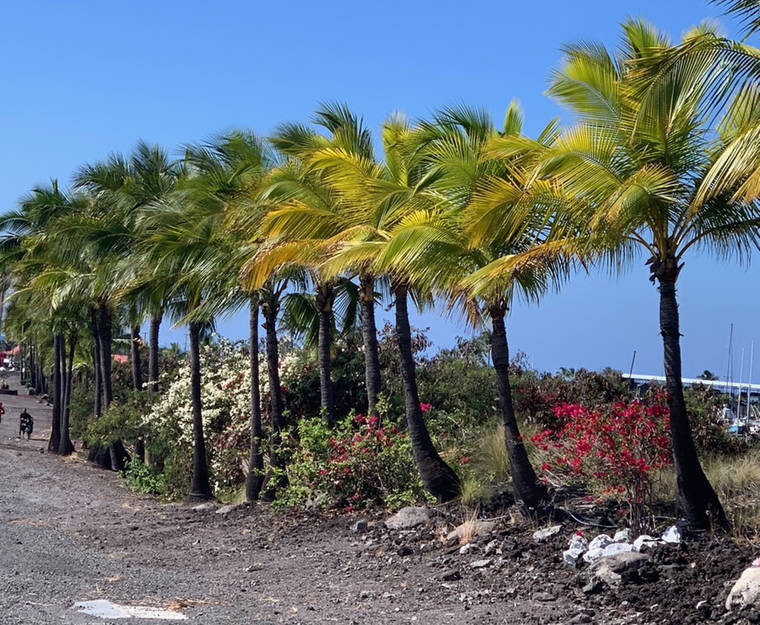Although heavy periods of rainfall in some parts of our island have caused the loss of essential nutrients, other areas have experienced dry conditions. Some areas were even suffering from drought.
Parts of the windward side received enough precipitation to remove nutrients such as nitrogen and actual top soil as well. West Hawaii received much less, but with our excessively porous rocky areas even 5 or 6 inches of rain can leach important elements essential to plant growth.
We have had several calls asking why some palms appear to be dying in makai landscapes. The answer seems fairly obvious if one notices the brown grass and wilted shrubs nearby. As long as we have sufficient summer and fall rains, our landscapes stay green.
But when irrigation has been restricted, and once the rains stop, the entire region experiences drought conditions. Thus, hundreds of shrubs and trees could be on the verge of dying unless we get a drenching storm.
Where rains in some locations leached nutrients from the soil, farms, lawns and gardens may need fertilizer now. These rains cause active growth of coffee, ornamentals, macadamia and most other plants. Active growth requires a good supply of nutrients to assure abundant crops and healthy plants. If you have not applied fertilizer recently, now is an important time.
As a general rule, new plantings should receive fertilizer every 3-4 months. Established landscapes might need less depending on the condition of the soil. Where rains and irrigation are sufficient, fertilizer applied now will perk up your garden. However, where there is insufficient moisture, fertilizing would aggravate the water stress condition, so hold off unless you can irrigate.
Here are some additional fertilizer tips.
• Be sure not to overfertilize nor wait too long between applications. Of course, the correct amount to use depends on the formula. The higher the formula, the less should be used. For example, a 20-20-20 is much more concentrated than an 8-8-8. A fertilizer also might be a slow release or a quick release type. A formula that contains the three major fertilizer elements of nitrogen, phosphorus and potassium in equal parts is common and sufficient for many uses. Use according to directions.
• For the lawn, turf specialists usually suggest enough fertilizer to give 1 pound of actual nitrogen per 1,000 square feet. The formulation used for grass is usually high in nitrogen such as a 21-7-14, 16-6-8, and 28-3-5. The first number in the formula represents nitrogen. This nutrient is very likely to be deficient after heavy rains. Number of applications per year depends on type and grass and soil.
• Don’t be confused by the vast array of fertilizer brands and formulas available. Most plants are not so specific in their nutritional needs that they can’t use and thrive on the same or similar fertilizer mixtures. The numbers represent the percent of nutrients in a bag. The middle number represents phosphorus, which is sometimes locked up in certain types of soils and not available to plants. Phosphorus encourages strong roots and cell development. Homeowners who use lots of fertilizer containing phosphorus might throughout a long period of time build up too much in the soil. Plants such as macadamia trees and their relatives are particularly sensitive to too much phosphorus.
• A formulation high in phosphorus and potassium such as 2-8-10 has less nitrogen than most other formulations and has a tendency to stimulate flowering and fruiting of many plants. This type is commonly referred to as “bloom aid” or “fruit trees special.” This type is often used on ornamental shrubs, trees and grasses.
• The minor elements of magnesium, zinc and iron are also important and should be included in a good fertilization program. Many ornamentals need extra applications of the minor elements; however, these minor or trace elements can be toxic if applied too heavily, so be careful.
• The soil should be moist when fertilizer is applied, and the fertilizer should be watered in immediately after application. Also, care should be taken to insure that the fertilizer material is applied over the entire root zone of the plant.
Remember: Take care of your garden like you would your pets, family and neighbors. Plants have feelings, too!

